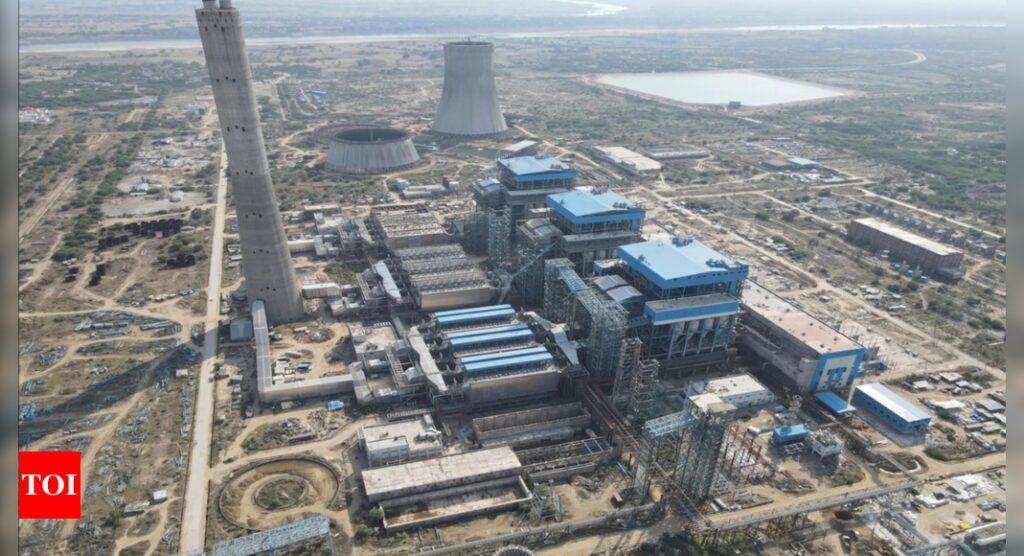[ad_1]
NEW DELHI: The government is looking at easing lending norms for new coal-fired power stations as it doubles down on the most-polluting fuel to meet a sharp uptick in electricity demand, even as media reports on Tuesday said France and the US are preparing to propose a ban on private funding for coal at the forthcoming COP-28 climate meet.
People aware of discussions in the power ministry indicate the requirement of PPAs (power purchase agreements) with distribution companies for lending to new coal-based power stations may be done away with to ease flow of funds.
The context for such a move was created on November 6 when power minister R K Singh told his counterparts from states that India has to start work on 30,000 MW (megawatt) new thermal generation capacity on top of 50,000 MW already underway to avoid electricity shortage in future.
At an average construction cost of Rs 8.3 crore per MW of coal-fired power estimated by a power ministry report in May, setting up the additional 30,000 MW capacity will entail investments of almost Rs 2.5 lakh crore. Given the 70:30 debt:equity ratio for power projects, it will entail a debt exposure in excess of Rs 1.7 lakh crore for lenders.
The figures reach astronomical proportions if the 50,000 MW coal-based capacity under implementation is taken into consideration, though admittedly at least half of these projects would have been planned at lower costs and must have secured funding.
Delinking funding from PPAs for new projects also fits into the ministry’s aim of gradually moving away from the PPA regime, which is short on flexibility, to make the power market more responsive, reduce cost for distribution utilities and consumers through competition.
The push for expanding coal-based generation capacity comes on the back of power demand posting annual growth of 20% in August, September and October. Peak demand touched 2.4 lakh MW this year against 1.9 lakh MW in 2017-18. “If the peak grows higher, we may not be able to meet it,” Singh had pointed out at the state power ministers’ conference.
The plant load factor, or spinning rate, of coal-based plants has risen to about 65% in line with rising demand in spite of a healthy production of green power. This shows India will need more coal-based power to keep the grid stable as the share of renewable power, which suffers from intermittency, increases.
Singh, aware of the international ramifications of falling back on coal, had candidly said, “There is going to be pressure on nations at COP-28 to reduce coal usage. We are not going to do this… we are not going to compromise on availability of power for our growth, even if it requires that we add coal-based capacity,” Singh had said in his opening remarks at the state power ministers’ meet.
People aware of discussions in the power ministry indicate the requirement of PPAs (power purchase agreements) with distribution companies for lending to new coal-based power stations may be done away with to ease flow of funds.
The context for such a move was created on November 6 when power minister R K Singh told his counterparts from states that India has to start work on 30,000 MW (megawatt) new thermal generation capacity on top of 50,000 MW already underway to avoid electricity shortage in future.
At an average construction cost of Rs 8.3 crore per MW of coal-fired power estimated by a power ministry report in May, setting up the additional 30,000 MW capacity will entail investments of almost Rs 2.5 lakh crore. Given the 70:30 debt:equity ratio for power projects, it will entail a debt exposure in excess of Rs 1.7 lakh crore for lenders.
The figures reach astronomical proportions if the 50,000 MW coal-based capacity under implementation is taken into consideration, though admittedly at least half of these projects would have been planned at lower costs and must have secured funding.
Delinking funding from PPAs for new projects also fits into the ministry’s aim of gradually moving away from the PPA regime, which is short on flexibility, to make the power market more responsive, reduce cost for distribution utilities and consumers through competition.
The push for expanding coal-based generation capacity comes on the back of power demand posting annual growth of 20% in August, September and October. Peak demand touched 2.4 lakh MW this year against 1.9 lakh MW in 2017-18. “If the peak grows higher, we may not be able to meet it,” Singh had pointed out at the state power ministers’ conference.
The plant load factor, or spinning rate, of coal-based plants has risen to about 65% in line with rising demand in spite of a healthy production of green power. This shows India will need more coal-based power to keep the grid stable as the share of renewable power, which suffers from intermittency, increases.
Singh, aware of the international ramifications of falling back on coal, had candidly said, “There is going to be pressure on nations at COP-28 to reduce coal usage. We are not going to do this… we are not going to compromise on availability of power for our growth, even if it requires that we add coal-based capacity,” Singh had said in his opening remarks at the state power ministers’ meet.
[ad_2]
Source link











More Stories
India’S Growth Forecast: S&P ups India’s FY’24 growth forecast to 6.4% on robust domestic momentum
India to remain fastest-growing major economy, but demand uneven: Poll
Jack Ma: Jack Ma gets back into business with ‘Ma’s Kitchen Food’